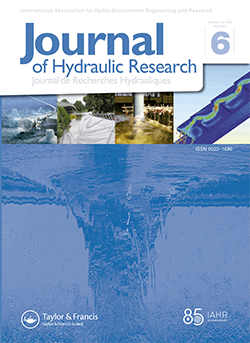Journal of Hydraulic Research (JHR). Vol. 58 | Issue 6, December 2020
The Journal of Hydraulic Research (JHR) publishes research papers in theoretical, experimental and computational hydraulics and fluid mechanics, relating to rivers, lakes, estuaries, coasts, constructed waterways, and some internal flows such as pipe flows. To reflect current trends in water research, articles that explore outcomes of interdisciplinary hydro-environment studies with a strong fluid mechanical component are especially welcome. Although preference is given to fundamental issues, papers focusing on important unconventional or emerging applications of broad interest are also appreciated.
IAHR members can access the latest issue online.
Overview
 This issue advances the theory and practice of unsteady stream-flows, hydraulic structures (floating breakwater, weirs, manholes), jets, floods, scour and instrumentation. The issue opens with a thought-provoking state-of-the-art paper on hysteresis of flow variables in unsteady stream-flows and demonstrates that the index-velocity and continuous slope-area methods are more suitable to monitor unsteady flows than the widely used stage–discharge approach. It is shown that, contrary to current perceptions, hysteresis can be captured even in small streams and frequently occurring run-off events.
This issue advances the theory and practice of unsteady stream-flows, hydraulic structures (floating breakwater, weirs, manholes), jets, floods, scour and instrumentation. The issue opens with a thought-provoking state-of-the-art paper on hysteresis of flow variables in unsteady stream-flows and demonstrates that the index-velocity and continuous slope-area methods are more suitable to monitor unsteady flows than the widely used stage–discharge approach. It is shown that, contrary to current perceptions, hysteresis can be captured even in small streams and frequently occurring run-off events.
Readers will also find papers on interesting topics like floating breakwaters (FB) in irregular waves and on hydrofoil weirs, and on floods, for which the datasets are freely available.
Two papers are on jets with one focused on experimental investigation of the effect of offset height effect on turbulent characteristics of twin surface jets and the other devoted to the computation of round thermal jets in an ambient cross flow.
Another paper presents an experimental study of a new manhole geometry designed to allow the installation of separate sewer systems in narrow streets.
A promising new formula for maximum local-scour depth prediction can be found in this issue, in addition to a paper that reports on the performance and limitations of three different acoustic Doppler current profilers (ADCP) used to measure bedload transport. The issue concludes with two discussions and closures.
State-of-the-art paper
Revisiting hysteresis of flow variables in monitoring unsteady streamflows

Marian Muste, Kyutae Lee, Dongsu Kim, Ciprian Bacotiu, Marcela Rojas Oliveros, Zhengyang Cheng and Felipe Quintero
Pages: 867-887 | DOI: 10.1080/00221686.2020.1786742
Research papers
Seyyed Mohammad Reza Tabatabaei and Hamid Zeraatgar
Pages: 888-898 | DOI: 10.1080/00221686.2019.1671518
Elham Bahman, Abdorreza Kabiri-Samani and Mohammad Navid Moghim
Pages: 899-909 | DOI: 10.1080/00221686.2019.1671519
Offset height effect on turbulent characteristics of twin surface jets
Mohammad S. Rahman and Mark F. Tachie
Pages: 910-919 | DOI: 10.1080/00221686.2019.1671522
Daniela Malcangio, Alan Cuthbertson, Mouldi Ben Meftah and Michele Mossa
Pages: 920-937 | DOI: 10.1080/00221686.2019.1684392
Experimental and numerical study of flood in a river-network-floodplain set-up
Vijay Kisan Mali and Soumendra Nath Kuiry
Pages: 938-956 | DOI: 10.1080/00221686.2019.1698471
The hydraulic performance of the storm chamber in a new manhole designed for separate sewer systems
Alaa Abbas, Iacopo Carnacina, Felicity Ruddock, Rafid Alkhaddar, Glynn Rothwell and Robert Andoh
Pages: 957-967 | DOI: 10.1080/00221686.2019.1698667
Near-bed eddy scales and clear-water local scouring around vertical cylinders
Francesco Coscarella, Roberto Gaudio and Costantino Manes
Pages: 968-981 | DOI: 10.1080/00221686.2019.1698668
Acoustic sampling effects on bedload quantification using acoustic Doppler current profilers
Slaven Conevski, Massimo Guerrero, Axel Winterscheid, Colin D Rennie and Nils Ruther
Pages: 982-1000 | DOI: 10.1080/00221686.2019.1703047
Discussion
Statistical analysis methods for transient flows – the dam-break case
Hubert Chanson
Pages: 1001-1004 | DOI: 10.1080/00221686.2020.1729266
Closure
Statistical analysis methods for transient flows – the dambreak case
Rui Aleixo, Sandra Soares-Frazão and Yves Zech
Pages: 1004-1005 | DOI: 10.1080/00221686.2020.1780505